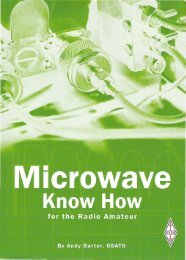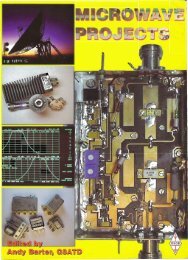Low Noise Amplifiers For 2304 MHz Using The HP ... - transistori.net
Low Noise Amplifiers For 2304 MHz Using The HP ... - transistori.net
Low Noise Amplifiers For 2304 MHz Using The HP ... - transistori.net
Create successful ePaper yourself
Turn your PDF publications into a flip-book with our unique Google optimized e-Paper software.
inductors for both the noise match and the input<br />
bias decoupling line. This technique allowed the<br />
LNA to achieve a noise figure of 0.4 dB or<br />
slightly less. Since this LNA was designed to be<br />
mounted in a standard enclosure I included some<br />
additional input etch which raised the noise<br />
figure slightly. <strong>The</strong> prototype LNAs I built were<br />
mounted in a box made from brass strips 1 inch<br />
tall. <strong>The</strong> SMA connectors were soldered directly<br />
to the printed circuit board and the brass walls. I<br />
was able to achieve 0.4 to 0.5 dB noise figures<br />
on all units built to date. Associated gain is 15 to<br />
16 dB typically. Bias point is Vds =2 volts and<br />
Ids = 15 mA.<br />
<strong>The</strong> schematic diagram for both the<br />
<strong>2304</strong> <strong>MHz</strong> and 3456 <strong>MHz</strong> LNAs is shown in<br />
Figure 2. <strong>The</strong> parts list is shown in Figure 3.<br />
Vgg<br />
C3<br />
INPUT<br />
C1 L1<br />
Q1 R3<br />
R1<br />
C2<br />
R2<br />
C4<br />
OUTPUT<br />
Figure 2. Schematic Diagram for <strong>2304</strong> and 3456<br />
<strong>MHz</strong> LNAs<br />
C1,C2, 8.2 to 10 pF chip capacitor<br />
C4<br />
C3,C5 1000pF // .01uF chip capacitor<br />
L1 <strong>2304</strong> <strong>MHz</strong> , length = .5 inch<br />
3456 <strong>MHz</strong>, length = .3 inch<br />
.007”diameter with .075” soldered<br />
to input etch and .025” soldered to<br />
gate lead. Adjust for best NF<br />
Q1 Hewlett-Packard ATF-36077<br />
PHEMT<br />
R1,R2 50 Ω chip resistor<br />
R3 10 to 27 Ω chip resistor (effects<br />
gain and stability)<br />
R4 <strong>For</strong> operation from a power supply<br />
voltage of 5 volts, R4 = 200Ω - R3<br />
- R2<br />
Figure 3. Parts list for <strong>2304</strong> and 3456 <strong>MHz</strong><br />
LNAs<br />
3456 <strong>MHz</strong> LNA<br />
C5<br />
R4<br />
Vdd<br />
<strong>The</strong> 3456 <strong>MHz</strong> LNA including<br />
component placement is shown in Figure 4. <strong>The</strong><br />
LNA design is very similar to the <strong>2304</strong> <strong>MHz</strong><br />
LNA. It also uses a wire inductor for the input<br />
noise match and a microstripline match for the<br />
output <strong>net</strong>work. A small resistor in series with<br />
the drain is used to lower gain and improve<br />
stability.<br />
INPUT<br />
Vdd<br />
REDUCE TO 2.0 INCHES<br />
ATF-36077<br />
3456 <strong>MHz</strong><br />
Vgg<br />
WB5LUA<br />
04/96<br />
ER=2.2<br />
H=.031<br />
OUTPUT<br />
Figure 4. 3456 <strong>MHz</strong> LNA showing component<br />
layout<br />
<strong>The</strong> prototype 3456 <strong>MHz</strong> LNAs were<br />
installed in brass housings similar to the <strong>2304</strong><br />
<strong>MHz</strong> LNA. <strong>Noise</strong> figures of 0.6 to 0.7 dB were<br />
obtained along with 13 to 14 dB gain. <strong>The</strong><br />
resistor in series with the drain can be lowered in<br />
value to increase gain and lower noise figure<br />
slightly. Somewhat lower noise figure could<br />
possibly be obtained by cutting off the input 50<br />
Ω microstripline and placing the input connector<br />
adjacent to the input blocking capacitor. Bias<br />
point is Vds =2 volts and Ids = 15 mA.<br />
5760 <strong>MHz</strong> LNA<br />
<strong>The</strong> 5760 <strong>MHz</strong> LNA including<br />
component placement is shown in Figure 5. <strong>The</strong><br />
LNA uses microstripline matching <strong>net</strong>works for<br />
both the input noise match and output gain<br />
match. Some resistive loading in the drain circuit<br />
is required for unconditional stability, according<br />
to the computer analysis. However, several<br />
LNAs have been built without this resistor with<br />
no problems experienced.




